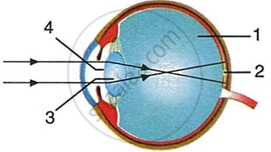Advertisements
Advertisements
Question
The far point of a myopic person is 80 cm in front of the eye. What is the nature and power of the lens required to correct the problem?
Solution
The person is suffering from an eye defect called myopia. In this defect, the image is formed in front of the retina. Hence, a concave lens is used to correct this defect of vision.
Object distance, u = infinity = ∞
Image distance, v = – 80 cm
Focal length = f
According to the lens formula,
`1/"v" - 1/"u" = 1/"f"`
`1/(-80) - 1/(-∞) = 1/"f"`
`1/(-80) = 1/"f"`
f = −80 cm = −0.80 m ...(concave lens)
∴ power of modified lens,
P = `1/"f"`
= `1/(-0.80 "m")`
= −1.25 D
A concave lens of power −1.25 D is required by the person to correct his defect.
RELATED QUESTIONS
What is myopia?
List three common refractive defects of vision. Suggest the way of correcting these defects.
A student is unable to see clearly the words written on the black board placed at a distance of approximately 3 m from him. Name the defect of vision the boy is suffering from. State the possible causes of this defect and explain the method of correcting it.
Which defect of vision can be rectified:
by using a convex lens?
An eye has a near point distance of 0.75 m. What sort of lens in spectacles would be needed to reduce the near point distance to 0.25 m? Also calculate the power of lens required. Is this eye long-sighted or short-sighted?
The defect of vision in which the eye-lens of a person gets progressively cloudy resulting in blurred vision is called:
(a) myopia
(b) presbyopia
(c) colourblindness
(d) cataract
Name the following:
The eye defect caused due to shortening of the eye ball from front to back.
Differentiate between members of the following pair with reference to what is asked in the bracket.
Rods and cones (sensitivity).
Describe the mechanism of focusing the image of a distant object in your eye when you raise your head after reading a book.
What is Hypermetropia (far sightedness)?
When do we consider a student sitting in the class to be myopic? List two causes of this defect. Explain using a ray diagram how this defect of eye can be corrected.
Select the odd one in the following series:
Endolymph, Tympanic membrane, Semi-circular canal, Blind spot.
Draw a neat labeled diagram to show how hypermetropia can be rectified.
Given below is a diagrammatic representation of a defect of the human eye:

(i) Identify the defect.
(ii) Mention two reasons for the above defect.
(iii) State how the defect can be rectified.
(iv) Name the part of the eye responsible for maintaining the shape of the eyeball.
Differentiate the eye defects: Myopia and Hypermetropia
A student sitting at the back of the classroom cannot read clearly the letters written on the blackboard. What advice will a doctor give to her? Draw ray diagram for the correction of this defect.
When do we consider a person to be myopic or hypermetropic? Explain using diagrams how the defects associated with myopic and hypermetropic eye can be corrected?
Name the following:
Two kinds of accomodations.
Given alongside is a diagram depicting a defect of the human eye. Study the same and answer the questions that follow:
 |
- Name the defect shown in the diagram.
- Give two possible reasons for this defect.
- Name the parts labelled 1 to 4.
- Name the type of lens used to correct this eye defect.
- Draw a labelled diagram to show how the above mentioned defect is rectified using the lens named above.
